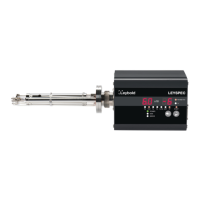69 300781172_002_C0 - 01/2019 - © Leybold
Maintenance
11.3.7 Calibrate sensitivity of the SEM
Procedure:
1. Introduce the gas so that the pressure at the place where the RGA is installed
will be between 1 x 10
-4
Pa and 1 x 10
-3
Pa. We recommended using N
2
or Argon
gas.
2. Decide your required operating sensitivity for the SEM.
If you set a high sensitivity, the SEM can detect small fluctuation, but its life
shortened.
The standard sensitivity for each model is as follows:
LEYSPEC view: 5 x 10
-3
A/Pa
LEYSPEC ultra : 12.5 x 10
-3
A/Pa
3. Calculate the calibration current in Amps [A] from sensitivity [A/Pa] and pressure
in Pascals [Pa].
Calibration Current [A]
= Sensitivity [A/Pa] × Calibration Pressure [Pa]
For example: If the sensitivity is 5 x 10
-3
A/Pa and the calibration pressure is
5 x 10
-4
Pa, then calibration current is 2.5 x 10
-6
A
4. Create a “calibration mode” recipe.
5. Enter the setting current on the recipe. The shipping standards are as follows:
LEYSPEC view: 2.5 x 10
-6
A at 5 x 10
-4
Pa
LEYSPEC ultra : 6.25 x 10
-6
A at 5 x 10
-4
Pa
Purpose: Calibrate secondary electron multiplier (SEM) sensitivity to measure with
constant sensitivity. The SEM amplifies small ion currents using a cascade of
secondary electrons which are generated by accelerated those secondary
electrons. The amplification rate of the secondary electrons is in inverse
proportion to the measurement current intensity and the number of hours
operated. You can restore the amplification rate by raising the voltage supplied
to the SEM. Perform the calibration in high pressure to avoid the possibility of
shortening the life of the SEM or causing fluctuating readings from electrical
discharge.
Cycle: The cycle depends on frequency of use. If you use the RGA only in FC mode,
you do not need to make this calibration.

